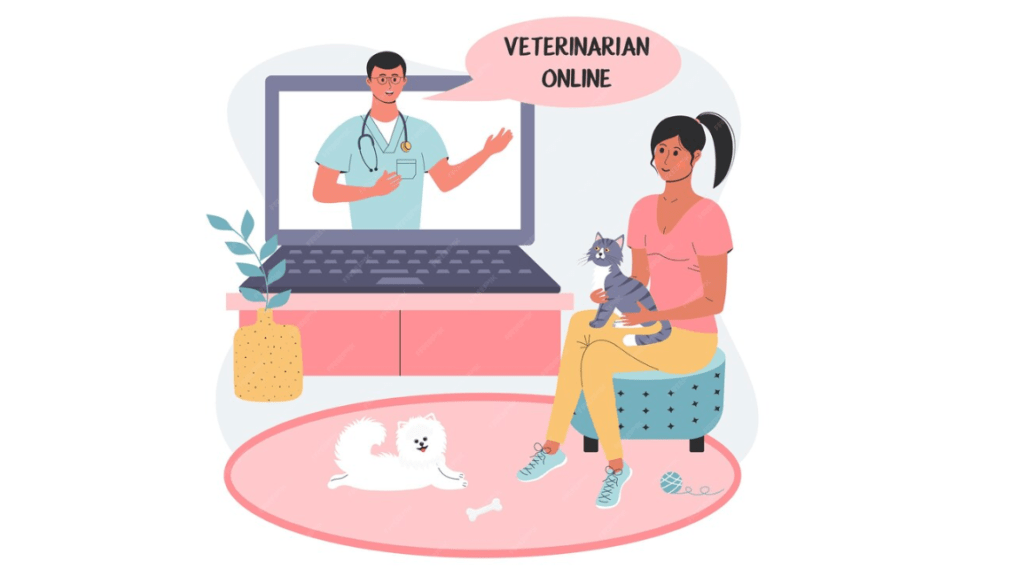Have you ever faced a situation where you need a vet consultation for your pet? or some situation where you are in no position to get out of your house to the vet for a one-to-one consultation? Contemporary veterinary telemedicine has bridged the gap between vets and pet owners regarding the well-being of our pets. But one of the biggest questions I often hear from my fellow pet parents or caregivers is that online vets are untrustworthy, which raises the question, is a virtual vet worth it?

The rise of telemedicine in veterinary care alters how we care for our canine companions. This novel concept enables pet owners to obtain professional advice for their canines from the peace of their own homes. While it is convenient, you must remember that each dog is unique. What works for one person may only work for one person.

When contemplating videoconferencing for your dog, it’s critical to examine their individual needs, whether they’re routine check-ups, chronic condition management, or the restrictions of virtual consultations. The key to guaranteeing their well-being is to tailor their care. This article will delve deep into the facts and explain the pros and cons of availing online vet services.
Also Read: Decoding 10 Common Dog Aggression Myths
What is Veterinary Telemedicine?
Veterinary telemedicine is a subset of telehealth in which information and communication technologies deliver animal health care services. It permits audio, video, or data transmission for online counseling, diagnosis, and treatment. This method connects clients and patients in one region with veterinary practitioners in another, breaking geographical barriers. Veterinary telemedicine is a tool that improves access and quality of care, not a distinct profession. It enables veterinarians to provide expert advice and gives pet owners access to essential healthcare resources, thereby helping our animal companions’ health and well-being.

Advantages of Veterinary Telemedicine Care
Telemedicine has transformed how we obtain healthcare treatments in recent years. This novel technique, which uses technology to diagnose and treat dogs or pets remotely, has revolutionized human medicine and made its way into animal care. Telemedicine in veterinary practice has various advantages, including enhanced accessibility, convenience, and cost-effectiveness. It does, however, create particular issues that must be addressed. In this essay, we will look at the function of veterinary telemedicine treatment, including its advantages and disadvantages.
Also Read: How to Detect Mammary Cancer in Dogs: 10 Signs
1. Accessibility and Convenience
Veterinary telemedicine care gives pet (dog) owners unprecedented access, especially those who live in distant places or face transportation issues. Pet owners can communicate with physicians from their homes through video calls or internet platforms using telemedicine. This accessibility extends to after-hours circumstances where quick in-person veterinarian care may be unavailable. Telemedicine gives pet owners comfort and peace of mind by reducing the necessity for physical visits.
Due to large travel distances and limited local resources, pet owners in rural or underdeveloped locations frequently need help to receive competent veterinary care. Telemedicine bridges this gap, helping ensure pets in rural areas receive the required care. It’s a game changer for people who live in areas where the nearest veterinarian is many hours away.
Furthermore, veterinary telemedicine is exceptionally convenient. It enables flexible scheduling, eliminating the need to take time off work or juggle other commitments to schedule a veterinary appointment. The option to contact a veterinarian at a convenient time rather than during clinic hours can significantly impact pet owners’ lives.

2. Reduced Stress for Pets
When visiting a veterinary clinic, dogs may experience worry and anxiety. The strange surroundings, the proximity of other people’s pets, and even a limousine ride to the clinic can all be stressful. Telemedicine appointments allow pets to remain in their usual settings and can help minimize stress. This is especially useful for creatures who are nervous, elderly, or have difficulties traveling.
When a pet is worried or afraid, the relevancy of the diagnosis suffers. The ability of telemedicine to keep pets well-behaved in their home setting allows vets to monitor their natural conduct, which can be critical in reaching an accurate diagnosis. It may also result in more precise therapy suggestions.

Veterinarian telemedicine is a godsend for senior dogs. They frequently have mobility issues, making travels to the clinic complex. Thanks to telemedicine, they can get the care they need without the added stress of a car ride and a potentially scary clinic visit. This method examines our pets’ mental well-being and contributes to their health.
Also Read: Can steroids cause Pancreatitis in dogs? Know 7 Important Things.
3. Cost-Effectiveness
Veterinary telemedicine provides both pet owners and veterinarians with cost-effective alternatives. Virtual consultations for pet owners can save travel fees and lessen the necessity for time off work. Minor health issues can also be addressed quickly through telemedicine, potentially avoiding the need for lengthy and costly in-person appointments. This is especially important for pet owners on a limited budget.
The cost-effectiveness of telemedicine can also assist veterinarians. It can help them improve the efficiency of their workflow, permitting them to spend their time and resources better. Telemedicine can be used for routine follow-ups or discussions for non-urgent concerns, freeing up time for in-person visits when necessary. This efficient resource utilization benefits both veterinarian and their patients.

4. Continuous Care and Monitoring
Veterinary telemedicine provides both pet owners and veterinarians with cost-effective alternatives. Virtual consultations for pet owners can save travel fees and lessen the necessity for time off work. Minor health issues can also be addressed quickly through telemedicine, potentially avoiding the need for lengthy and costly in-person appointments. This is especially important for pet owners on a limited budget.

The cost-effectiveness of telemedicine can also assist veterinarians. It can help them improve the efficiency of their workflow, permitting them to spend their time and resources better. Telemedicine can be used for routine follow-ups or discussions for non-urgent concerns, freeing up time for doctor visits when necessary. This efficient resource utilization benefits both veterinarian and their patients.
Veterinary telemedicine provides a lifeline to veterinarians for pets recovering from surgery or receiving treatment. It enables close monitoring, early discovery of problems, and fast changes to the treatment plan if needed. Pet owners receive counsel and reassurance, which reduces anxiety during a stressful time.

Triage and Emergency Support
Veterinary telemedicine can be a useful triage technique, assisting veterinarians in prioritizing cases depending on severity. Pet owners can speak with a veterinarian remotely to determine whether their pet’s condition requires immediate attention or can be managed at home. This guarantees critical patients are treated immediately while avoiding unnecessary emergency visits.

Telemedicine can provide initial support and direction until the pet can be brought to a veterinarian facility in emergencies where quick in-person care is impossible. For example, suppose a pet consumes something dangerous or sustains an injury. In that case, a telemedicine consultation can advise the owner on rapid first-aid measures on the way to the clinic.

Disadvantages and Considerations of Online Consultation for Dogs
While veterinary telemedicine has various benefits, it is critical to understand its limitations and implications to make well-informed decisions about its use for your pet’s healthcare.
A. The Inability to Conduct Physical Exams
The inability to physically inspect a pet is one of the fundamental obstacles to veterinary telemedicine. Hands-on exams are essential for a thorough inspection since they allow veterinarians to palpate, auscultate, and visually evaluate many areas of a pet’s health. Some illnesses, particularly those requiring fine-tuned diagnostics or surgery, necessitate a tactile assessment that telemedicine cannot offer.

B. Diagnostic Limitations in Certain Conditions
Certain medical disorders necessitate diagnostic or laboratory testing unavailable via telemedicine. While discussions and observations can aid in identifying common problems, conditions requiring X-rays, ultrasounds, or significant blood testing may necessitate an in-person visit. When adopting telemedicine, it is critical to understand diagnostic processes’ limitations and importance.
C. Insufficient Follow-up with the Same Veterinarian
It is not always assured that you will have follow-up appointments with the same veterinarian while using telemedicine. Continuity of care and long-term collaboration with a veterinarian might be critical to your pet’s health. Telemedicine systems may connect you with multiple professionals, potentially disturbing your pet’s treatment.
D. Vets have less responsibility.
With telemedicine, veterinarians may be less responsible for a pet’s well-being. The lack of direct interaction may result in missed cues or a diminished sense of accountability. Pet owners must take the initiative to share complete information and advocate for their pets.
E. Communication Gaps as a Result of Virtual Interface
Through a virtual interface, effective communication might be difficult at times. Miscommunications or technical faults can hamper the exchange of critical information. To ensure that the pet’s requirements are correctly understood and met, open and honest communication between the pet owner and the doctor who treats the pet is crucial.

When to Consider Veterinary Telemedicine
Understanding when to use veterinary telemedicine is critical for getting the most out of this vital tool in pet care. Here are a few examples of when telemedicine can be beneficial:
A. Routine Health and Wellness Exams
Telemedicine can be a practical choice for routine check-ups, vaccines, and general wellness evaluations. These visits frequently include talks, health updates for your pet, and future care planning. Veterinary telemedicine allows you to consult with a veterinarian without performing a physical examination, making it a fantastic option for maintaining your pet’s preventive healthcare.
B. Managing Chronic Diseases
Telemedicine can be extremely beneficial if your pet suffers from a chronic ailment such as diabetes, arthritis, or skin allergies. Virtual consultations can be used to conduct regular follow-ups to monitor the condition, change treatment plans, and address issues. This ensures your pet’s comfort and quality of life while reducing the need for stressful medical visits.

C. Consultations on Behaviour
Behavioural problems in pets can be difficult and distressing for the pet and the owner. Telemedicine lets you consult a veterinarian behaviourist who may observe your pet’s behaviour from home. This provides valuable information for diagnosing and treating behavioural issues.
D. Managing Chronic Diseases
Telemedicine can be extremely beneficial if your pet suffers from a chronic ailment such as diabetes, arthritis, or skin allergies. Virtual consultations can be used to conduct regular follow-ups to monitor the condition, change treatment plans, and address issues. This ensures your pet’s comfort and quality of life while reducing the need for stressful medical visits.
E. Consultations on Behaviour
Behavioural problems in pets can be difficult and distressing for the pet and the owner. Telemedicine lets you converse with a veterinarian behaviourist who may observe your pet’s behavior from home. This provides useful information for diagnosing and treating behavioral issues.
Choosing a Veterinary Telemedicine Provider
Choosing the appropriate veterinary telemedicine provider is critical to your pet’s health. Here’s how to make an educated decision:

Considerations When Choosing a Provider
Professional Qualifications: Look for vets who are licensed. Ensure that the veterinarians have telemedicine experience and skills.
Services Offered: Consider the variety of services provided by the company. Some platforms include unlimited virtual visits, live chats, behavioural consultations, diet and nutrition advice, and insurance claim assistance.
Consider the pricing structure: Some service providers charge a monthly fee, while others charge a fee per consultation. Choose a plan that meets your pet’s demands and your budget.
User-Friendly Platform: Whether you’re working on a mobile app or a website, use a simple platform. User-friendly interfaces can improve your and your pet’s enjoyment.
Accessibility: Check that the provider’s hours of operation coincide with yours. Providers available 24 hours a day, seven days a week, can be very useful in an emergency.

Ensure the Provider Follows Legal and Ethical Standards
Licensing and Regulations: Confirm that the provider follows local and state laws. In the United States, veterinarians must be licensed in the state where the patient resides.
Privacy and security: Ensure the platform meets strict data security and patient confidentiality standards. The medical information about your pet should be kept private.
Read reviews and ask for recommendations from other pet owners who have utilized the service. The provider should regularly give high-quality care and respond quickly.
Here are several veterinary telemedicine service providers in the United States:
Vetster: For $19.99 monthly, you can have unlimited web-based consultations and live chats with a licensed veterinarian.
Fuzzy Pet Health: Consult licensed veterinary professionals, tech techs, and assistants via live chat or video.
Airvet: Provides limitless video consultations, follow-ups, access to behaviour and training experts, individualized food and nutrition plans, and insurance claim assistance.
Consider researching the best veterinary telemedicine services for 2023, as reported in WIRED, and other firms and platforms in the area, such as TeleVet, Chewy, Pawp, Dutch, PetsApp, Anipanion, and Vetster. The range of alternatives allows you to select the one that best meets your pet’s needs and your preferences.

Ethical Considerations While Using Veterinary Telemedicine
To achieve the best results when using veterinary telemedicine for your dog’s wellness, it’s critical to follow these ethical principles:
The welfare of your pet is the most important ethical consideration. Make their health, comfort, and happiness a priority. When telemedicine is appropriate for their requirements, they should use it, but they should be bold and seek in-person care. Always act in the best interests of your dog.

Using telemedicine responsibly entails providing correct information, following treatment recommendations, and respecting the provider’s competence. Additionally, confirm that your chosen telemedicine provider follows legal and ethical guidelines, which will protect your pet’s healthcare journey. Ethical decisions improve your dog’s quality of life while utilizing the benefits of telemedicine.
Final Thoughts
Veterinary telemedicine appears as a valued companion in the ever-changing landscape of pet treatment. It provides ease, accessibility, and support for your dog’s health. However, while the digital sphere offers numerous opportunities, it is critical to navigate it carefully. Always prioritize your dog’s welfare, and use telemedicine to supplement traditional veterinary care. You can ensure that your four-legged family member enjoys the best of both worlds by balancing virtual and in-person care, resulting in a healthier, happier, and more satisfying existence for your beloved pet. It is strongly advised to use online vet consultation in emergencies or for routine checkups only, while physical check-ups by a vet could help a lot better.
What is the cost of veterinary telemedicine services?
The cost of veterinary telemedicine services varies depending on the supplier, the type of service, and whether the consultation is one-time or on a subscription basis. A single telemedicine appointment may cost between $30 and $100. Some suppliers also give monthly memberships, ranging between $20 and $50. To select the most appropriate and cost-effective choice for your scenario, analyze your pet’s demands and evaluate the pricing and services given by different telemedicine providers.
How do I choose the right telemedicine provider for my dog?
Choosing the best telemedicine service for your dog entails considering several things. Look for licensed veterinarians with telemedicine experience. Examine the platform’s service offerings, cost, and usability. Check for emergency availability 24 hours a day, seven days a week. Seek advice from other pet owners and check reviews to ensure quality. Ascertain that the service adheres to legal and ethical norms. Finally, choosing a provider who meets your pet’s individual needs as well as your preferences can assist in ensuring the most excellent care for your furry friend.
Can telemedicine be used for emergencies?
Telemedicine can be used for initial emergency assessment and advice, especially when rapid in-person care is unavailable. Telemedicine consultations can provide vital first-aid guidance while transporting your pet to a veterinarian in emergencies such as poison ingestion or minor injuries. However, seeking immediate in-person veterinary care is essential in urgent or life-threatening situations. Telemedicine should not be used to replace emergency services but rather as a bridge for providing preliminary assistance in life-threatening situations.
Does pet insurance cover telemedicine appointments?
Pet insurance policies and providers differ in their coverage for telemedicine sessions. Some pet insurance policies may cover telemedicine consultations, while others may not. Researching your unique policy or contacting your pet insurance provider about telemedicine coverage is critical. Furthermore, the availability and scope of coverage may vary depending on the reason for the telemedicine consultation, so it’s best to verify with your insurance carrier to comprehend the conditions and requirements of your policy.
